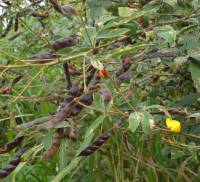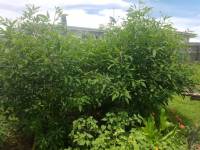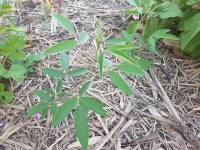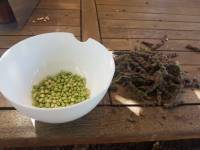Pigeon Pea
Botanical Information
| Botanical Information | |
|---|---|
| Order | Fabales |
| Family | Fabaceae |
| Genus | Cajanus |
| Common Name | Pigeon Pea |
| Species | C. cajan |
Maturity days
- 115
Planting Months
| Planting months | |||||||||||
|---|---|---|---|---|---|---|---|---|---|---|---|
| Jan | Feb | Mar | Apr | May | Jun | Jul | Aug | Sep | Oct | Nov | Dec |
| X | X | X | X | X | X | X | X | X | X | ||
Permaculture uses
| Permaculture uses | ||
|---|---|---|
| Usage 1 | Usage 2 | Usage 3 |
| Pioneer | Nitrogen Fixer | Vegetable |
Growing condition comments
| Growing Condition | Comment |
|---|---|
| Drought Tolerant | Yes |
| Humidity tolerant | Yes |
| Planting area | Ground |
| Sunlight | Full_sun |
Photos
Recipes
Beans are done when they can be easily mashed with a fork – make sure to test a few in case they have not cooked evenly.
Short comments
Legume shrub. Edible peas. Protein source. Lives for about five (5) years.
Provides habitat for small birds in the garden.
General comments
A woody, leguminous shrub, to 3.6 m, with yellow and red flowers.
- Companion plant with sweet potato.
- Use as a chop and drop.
Ecology
It is hardy, widely adaptable and tolerant of temperatures as high as 35°C. It can be killed by heavy frost. An average annual rainfall between 600 and 1,000 mm is most suitable. However, it can be grown in humid areas, even over 2,500 mm of rainfall and is renowned for its drought tolerance. It gives economic yields of seeds in areas where rainfall averages about 400 mm annually. Although it cannot withstand waterlogging it can be grown in a wide range of soils, as it tolerates low fertility. Some cultivars are tolerant of salinity and aluminium. A pH range of 4.5 - 8.4 is tolerated.
Uses
- Food: seeds are 25% protein, can be eaten fresh or as split dried peas, are used for dhal in India, contain 5 times more Vitamin A and C than green peas. The leaves and young shoots can be eaten cooked, they are fibrous and have a strong spicy odour.
- Animal Fodder: an excellent feed for cattle, pigs and poultry. Leaves make animal fodder.
- Green Manure: incorporate the plants as they flower, bee attracting. Use as a cover crop in the wet season
- Mulch production: can be cut many times in a season.
- Alley cropping: provides nitrogen, habitat and soil stabilisation.
- Windbreaks: suitable as a shelterbelt around vegetable gardens. Plant around young fruit trees.
- Shade: open canopy shelters young delicate plants.
- Firewood: twigs make fire wood.
- Living trellis: tomatoes, beans etc.
Recommended Planting Time: Spring, or during the wet season, soil temperature should be at least 25°C for germination, a higher soil temperature will give a more even germination.
Food
- Cook green peas like fresh peas
- Cook dried peas like normal dried peas, beans or lentils
- Can be ground into flour
- Used to make Dahl - a thick stew or puree of beans or legumes.
Planting Depth
It can be direct-seeded, or planted into forestry tubes and later transplanted. Sow the seed 2.5 cm deep.
- Soaking seeds overnight will improve germination.
- Protect young plants from all grazing animals.
Inoculant
A group of bacteria called Rhizobium live in a symbiotic relationship with many legumes. This is a big advantage to the plant, as it is able, once inoculated, to produce its own nitrogen, from the soil air. The bacteria are stored in peat, and as this is a living culture, it must be treated with care. It should be stored in the fridge and used within 3 months. Do not separate from the seed packet as the inoculant attached is specific to the individual legume. To use, moisten the seed with a small amount of milk or water and stir in the inoculant until seeds are coated. Do not inoculate the seed until you are ready to sow it and do not leave the inoculated seed in the sun.



